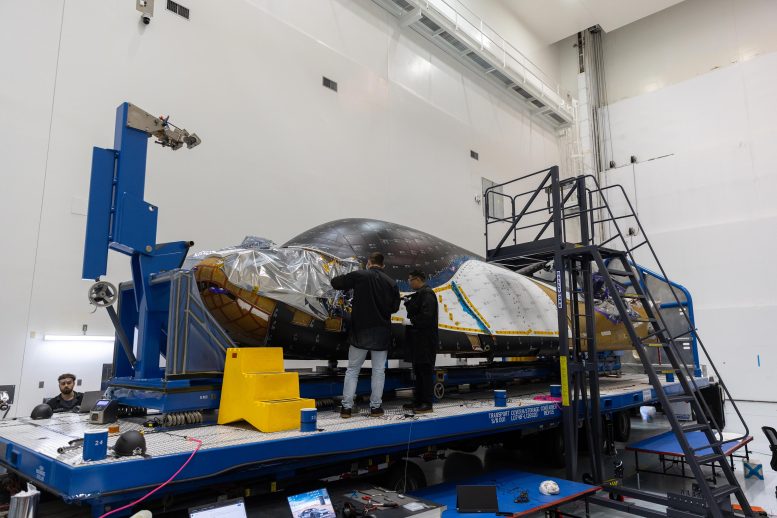Illustration of Sierra Space’s first Dream Chaser, called DC#1 (Tenacity). Credit: Sierra Space
Sierra Space’s Dream Chaser Tenacity, part OURinitiative to improve commercial supply missions International Space Station, arrived at the Kennedy Space Center on its first mission. After rigorous pre-launch testing, it is scheduled to deliver 7,800 pounds of payload using a ULA Vulcan rocket.
As part of NASA’s efforts to expand commercial resupply in low Earth orbit, the Sierra Space unmanned space plane has arrived at NASA’s Kennedy Space Center in Florida ahead of its maiden flight to the International Space Station (ISS).
The Dream Chaser spacecraft, named Tenacity, arrived at Kennedy on May 18 in a climate-controlled shipping container from NASA’s Neil Armstrong Test Facility in Sandusky, Ohio, and joined its companion Shooting Star cargo module that arrived on May 11.
Pre-launch testing and preparation
Before arriving at Kennedy, the space plane and its cargo module underwent vibration testing atop the world’s largest-capacity and most powerful spacecraft shaker system inside the agency’s Space Environments Complex, exposing the stack to vibrations similar to those it will experience during launch and re-entry into Earth’s atmosphere. After vibration testing, the duo moved to NASA’s In-Space Propulsion Facility and were exposed to low ambient pressure and temperatures ranging from -150 to 300 degrees. Fahrenheit.

Dream Chaser Tenacity, an unmanned Sierra Space cargo spaceplane, is processed at the Space Systems Processing Facility (SSPF) at NASA’s Kennedy Space Center in Florida on Monday, May 20, 2024. The spaceplane arrived inside an air-conditioned shipping container from the agency Neil Armstrong Test Facility in Ohio. Final testing and pre-launch processing will be completed within the SSPF High Section prior to Dream Chaser’s inaugural launch aboard a ULA (United Launch Alliance) Vulcan rocket from the nearby Cape Canaveral Space Force Station. Credit: NASA/Kim Shiflett
Final preparations at Kennedy
Upon arrival at Kennedy, the teams moved Dream Chaser Tenacity to a high bay within the Space Systems Processing Facility, where it will undergo final testing and pre-launch processing ahead of a launch planned for later this year.
The spaceplane will lift off on a ULA (United Launch Alliance) Vulcan rocket from Space Launch Complex-41 at the Cape Canaveral Space Force Station and is scheduled to deliver 7,800 pounds of cargo to the orbiting laboratory.
Remaining preflight activities at Kennedy include acoustic and electromagnetic interference and compatibility testing, completion of work on the spaceplane’s thermal protection system, and final payload integration.
Design and features of Dream Chaser
The Dream Chaser is a hovering space plane that measures 30 feet long and 15 feet wide. The unique winged design allows it to transport cargo to and from low Earth orbit and retain the ability to land on a NASA space shuttle-style runway. The 15-foot Shooting Star module can carry up to 7,000 pounds of cargo internally and has three external non-pressurized cargo racks.
The partially reusable transport system will fly at least seven cargo missions to the International Space Station as part of the agency’s effort to expand commercial resupply services in low Earth orbit. Future missions could last as long as 75 days and deliver as much as 11,500 pounds of payload.
While the Dream Chaser spacecraft is reusable and can return up to 3,500 pounds of cargo to Earth, the Shooting Star module is designed to eject and burn up during reentry, creating the opportunity to dispose of up to 8,500 pounds of debris with each mission.
Dream Chaser Tenacity is the first in Sierra Space’s planned fleet of spacecraft to help carry out these missions.
Certification and in-orbit operations
As part of the vehicle system certification process for future agency resupply missions, NASA and Sierra Space will test the spaceplane once it is in orbit. As Dream Chaser Tenacity approaches the space station, it will perform a series of demonstrations to demonstrate attitude control, translational maneuvers and abort capabilities. After completing the maneuvering demonstration, the space station astronauts will use the Canadarm2 robotic arm to grab the spacecraft and dock at the Earth-facing hatch.
After remaining in the orbiting laboratory for about 45 days, the space plane will be released from the station and return to land at Kennedy’s Launch and Landing Facility. After landing, the Dream Chaser is powered down, and the Sierra Space team will transfer it back to the processing facility to perform necessary inspections, unload the remaining NASA payload, and begin the process of preparing for the next mission.